#queen mary i
Text



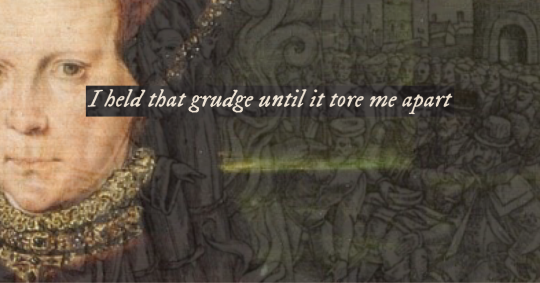
“And I feel like my castle’s crumbling down…”~ Castles Crumbling by Taylor Swift ft. Hayley Williams/// Queen Mary I
#mary i#taylor swift#henry viii#the tudors#catherine of aragon#tudor history#english history#tudor era#mary i tudor#queen mary i#queen mary i of england#mary i of england#mary tudor#castles crumbling
140 notes
·
View notes
Photo
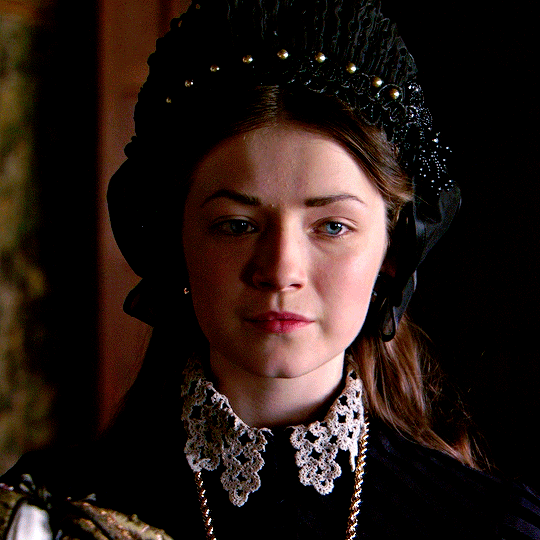

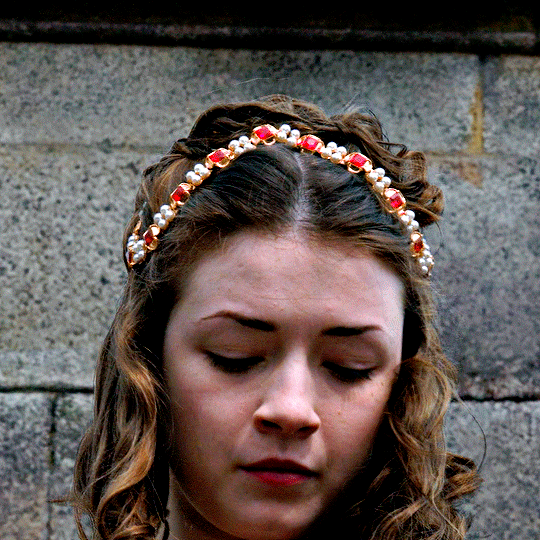


Sarah Bolger as Mary I · The Tudors 2.04
#the tudors#thetudorsedit#tudorerasource#mary i#queen mary i#sarah bolger#weloveperioddrama#perioddramaedit#perioddramasource#mine
429 notes
·
View notes
Text
the fact that Elizabeth I is titled "The Virgin Queen" implies that someone- possibly Mary I, possibly Lady Jane Grey, possibly Mary Queen of Scots- is "The Chad Queen."
#the virgin queen#the chad queen#virgin vs chad#i'm sorry#tudor memes#shitposting#history#elizabeth i#mary tudor#queen mary i#mary queen of scots#lady jane grey#tudors
63 notes
·
View notes
Photo
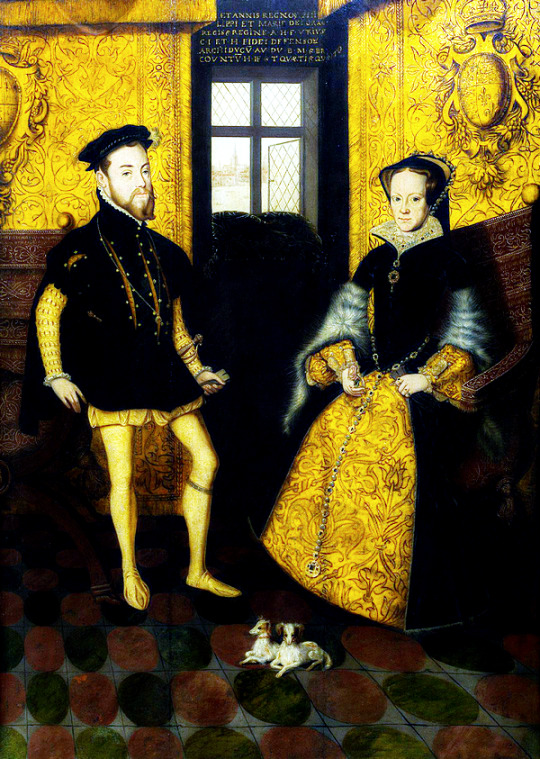
KING AND QUEEN OF ENGLAND AND IRELAND
Queen Mary I, of England and Ireland and her husband and consort King Philip II, of Spain and I of England and Ireland* attributed to Hans Eworth c.1558.
*Philip was granted the right to enjoy his wife’s titles during the term of their marriage under the Act for the Marriage of Queen Mary to Philip of Spain 1554.
#historyedit#mary i#mary i of england#Queen Mary I#Queen Mary I of England#mary tudor#philip ii of spain#Phillip II#Philip of Spain#edit#original edit#portrait
59 notes
·
View notes
Text





La Peregrina, A Queen Among Jewels
Pear-shaped and weighing in at a magnificent 223.8 grains of 55.95 carats, Phillip II of Spain's wedding gift surpassed every fantasy his bride, the newly crowned Mary I of England, could have imagined. Baptized La Peregrina (an expression from the groom's native language meaning "female wanderer"), the brilliant pearl was delivered directly to the queen, its priceless value reflecting the inestimable importance that a marriage treaty between England and Spain represented at the time.
Found on the coast of Panama in 1513 by an African slave, the pearl went down in history as a fine adornment much appreciated by royalty. In her well-known official portrait of 1554, Mary is depicted adorned with her wedding present, dangling from a bejeweled brooch on her chest. Queen Margaret, wife of Phillip III of Spain, wore it during celebrations of a peace treaty with the English in 1605. Two of the wives of Phillip IV of Portugal and Spain also had the privilege of wearing it — but the jewel would still pilgrimage through Europe and the world, and would end up not just under the possession of princesses and queens, but of other distinguished personalities.
After the end of the 16th and 17th centuries, La Peregrina would be mentioned in the annals of history again only in 1813, when Joseph, brother of Napoleon Bonaparte, filched it along with a significant part of the Spanish Crown Jewels, in his flight from Spain back to France. After the fall of Napoleon in 1815, the pearl's new owner moved to the United States, where he would eventually die and leave it to his nephew, Charles Louis, the future Napoleon III. During his own exile, this time in England, the descendant of the Emperor of the French sold it to the second Duke of Abercorn, and it was actually during this period that the family heirloom received its infamous name.
The pearl would remain in the Abercorn family for a century, being briefly lost by falling from its setting twice — first, disappearing between the cushions of a sofa in Windsor Castle; then, during a ball at Buckingham Palace. Fortunately, La Peregrina was found and returned to her owners in both occasions.
In 1913 the jewel was cleaned and polished, and as a result, lost approximately 203 grams. Yet it still remains today the largest symmetrical pearl of its shape, and in 1969, after being auctioned at Sotheby's, it once again became a husband's gift to his wife. Richard Burton bought it for $37,000 for his wife, the iconic actress Elizabeth Taylor.
Interestingly enough, Taylor decided to adorn her gift with a completely new design, one inspired by none other than the regal portrait of Mary I. Other smaller pearls, emeralds and rubies completed the piece, centering around the glorious Peregrina, now displayed as a Tudor styled choker.
#tudor history#tudor queens#tudor dynasty#history#culture#tudor era#mary i of england#mary tudor#elizabeth taylor#tudorqueens#history facts#queen mary i
46 notes
·
View notes
Text
In detailing the clothing she had made or altered in her first year as Queen, they show her at her most happy and optimistic.She was finally free of the political and religious restraints previously imposed by her father and more latterly by her half-brother, and was now, effectively, embarking on a new career. She was able at last to marry a man of her choice, and was seriously looking forward to having children.
-Mary Tudor's Wardrobe By ALISONJ.CARTER
#mary i of england#mary tudor#good queen mary#house of tudor#mary i#pearl of the kingdom#queen mary i
54 notes
·
View notes
Text
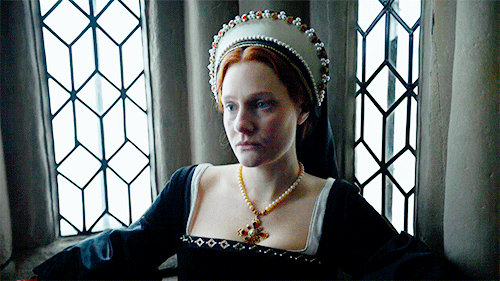
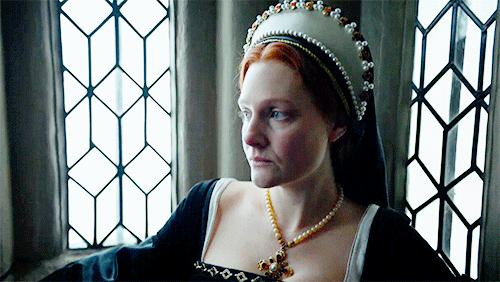
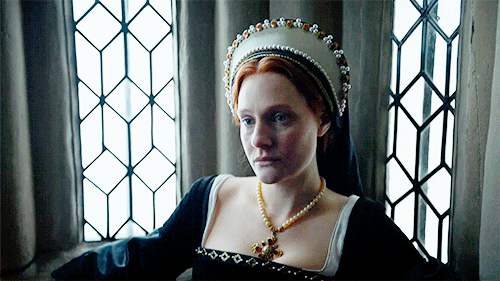
𝐑𝐎𝐌𝐎𝐋𝐀 𝐆𝐀𝐑𝐀𝐈 as 𝐌𝐀𝐑𝐘 𝐈 𝐎𝐅 𝐄𝐍𝐆𝐋𝐀𝐍𝐃
#mary i#becomingeelizabethedit#becoming elizabeth#perioddramaedit#mary tudor#LIKE A BOSS#queen mary i#romola garai#mine: perioddrama#mine.#rayedit.#mine: gifs#mine: history#period drama costumes#tudordrama#tudors
348 notes
·
View notes
Text

New in the Digital Library: this grant for Lyme Regis was formally issued on 14 June, 1554 and is signed "Marye the quene."
A grant of a weekly Friday market and two annual fairs to Lyme Regis. Queen Mary gives a warrant to an unidentified official to draw up the grant for the town of ’Kings Lyme’ [Lyme Regis] of a weekly Friday market and two annual three-day fairs in February and September: the grants to include all stallage, piccage [a fee for breaking ground at a fair], tollage and customs with the court of piepowder [a special tribunal for actions during the market or fair], as well as the right of correcting weights and measures; those attending the fairs may not be ’suyd arrested or molested in any suyte ... except it be for acc[i]ons and suyts onely rysyng... w[i]t[h]in the seid Fayers’. ’Where at the humble suyte and peticion of the Burgesses of our Towne of Kings Lyme in our Countie of Dorsett, we are right welle contented and pleaced ... to give and graunte unto the Burgesses of our seid Towne and to their Successours forev[er] one m[ar]kett to be kepte weekely w[ith]in our seid Towne on the Friday forev[er], And also t[w]o Fayres yerely there to be holden and kept, that is to say thone Fayre to begynne the firste day of February yerely forev[er], And there to conynue three dayes then next folowyng, And thother Fayre to begynne the xx [20th] day of September yerely and there to continue for three days then next folowyng’.
(via Grant of weekly market and two annual fairs... | MU Digital Library, University of Missouri)
#english history#british history#mary tudor#queen mary i#1500s#sixteenth century#secretary hand#manuscript#manuscripts#special collections#libraries#university of missouri#mizzou#fb#private collection#kelli h
38 notes
·
View notes
Text
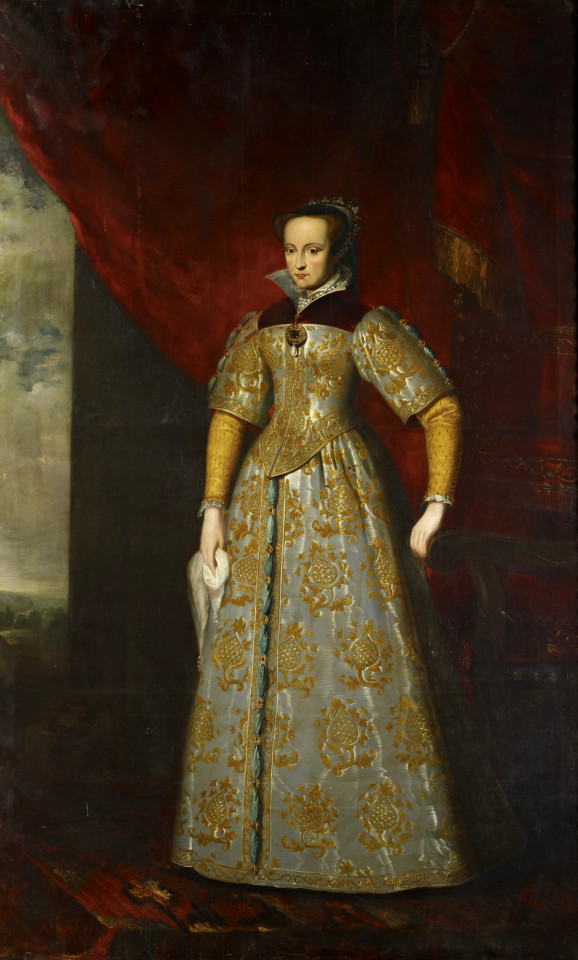
Queen Mary I Tudor (1516-1558). By J. B. Williamson.
#j b williamson#kingdom of england#mary tudor#queen mary i#house of tudor#full length portrait#queen mary tudor#full-length portrait
14 notes
·
View notes
Text
Is this the lost portrait of Mary I as Princess?
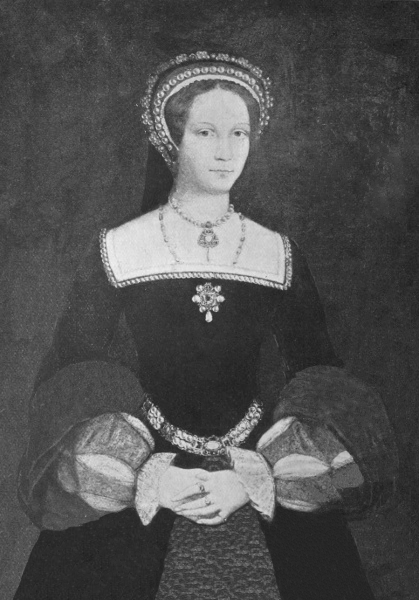
Let’s find out!
First of all, painting A(on left) is extremely similiar to this painting on right(painting B):
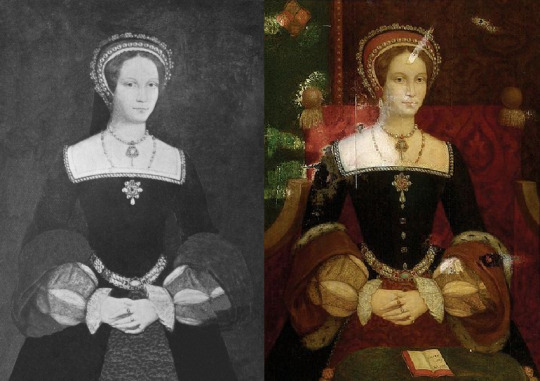
The face and proportions etc. But obviously B has very different background, some jewels are not in A. However they look as if made by same person. Or that one is an excellent copy, and the other is original.
This level of similiarity, is frankly astonishing. You’d think it is same painting after and prior to cleaning of later alterations! But it isn’t. Becase B is painting in Ashmolean Museum and nobody knows what lies beneath the layers of 19th century mixture on top of it. As far as I understand the description on their webpage, the painting not only wasn’t ever properly cleaned, it cannot be cleaned(with our current technology). They tried in 1976...but that had catastrophic results(thus those weird smudges.)
So what could be the explanation for this photo?
1)One is copy by excellent forger/by excellent painter. We once seen it with portrait of Margaret Beaufort. The copy made about 100 years later was very true to original in most aspects. Most being the key word here. Very few artist manage to do the perfect copy. This explain some of differences, Especially B was later altered or if B is the copy. But imo both look they have some alterations.
2)They were twins(twin portraits). By twin portraits we don’t mean exactly same portraits, but two portraits which are nearly same, but have some minor differecences. Catherine Parr had twin portraits, where posture was same, outfit was nearly same, just the gown and jewelry was different.
Here, however the jewels seem to be same, exactly the same and gown also. Unless of course, the quality of photos or alterations are hiding something. Hence could possibly be the case, we just can’t see it at the moment.
3)They were made exactly the same originally, and somebody altered heck out of B. (well almost exact same, amount of forepart you see is different+ some minor differences in french hood(in A it is smaller slightly). But it could be that they were ment to be same.)
Yet it doesn’t make sense for two exact same original portraits of Mary to be made in 1540s.
Unless both are copies, based upon single original, which predates them both! This seems to be most logical to me, but it could be any of the prior options.
I could only find photo of A, idk where it is located and B cannot be cleaned at the moment. Maybe in future technology will improve and it will be able, but right now we can’t tell what is altered what is not.
Because Ashmolean Museum doesn’t meantion the photo or any other version of this painting, I think it is sadly possible that this old photo is of painting which was lost during WW2. (usually the case with lost art.)
This 3rd option-both being copies, would explain why even A does not have perfectly accurate Tudor outfit. But at same time, it seems like A itself is subject of alterations, and some appear to be visible in the photo.
In lower half, obviously the girdle is missing, the pattern of fabric of forepart seems off(possible altered), the shape of oversleeves is wrong(they were never this small), there is like big smudge?/dark area on right(which i marked orange), and more cuts of undersleeves are partly see-through on both sides.

B doesn’t have such weirdness as far as I can tell. Though same problem with lack of girdle and too small oversleeves(+ the too wide forepart). On A the gap around waistline revealing forepart is more historically accurate, and it existing suggest the original painting could have been done in late 1530s/ealry 1540s. Because with Parr the gap disappeared.
And this is oviously the six-cut style undersleeves. This might help us narrow down dating of Streatham portrait. And once again, it is on Mary!
But what is most interesting to me is that those shadows behind her head are as if she wore gable hood! One back veil pinned up, one down.
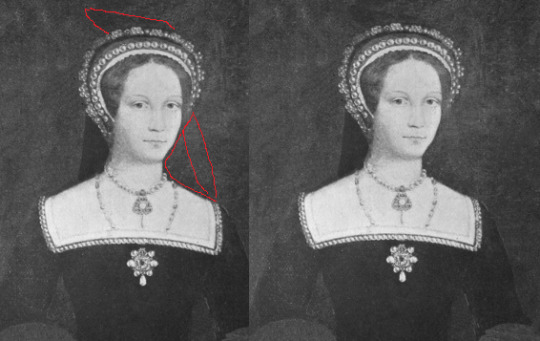
Except both on same side! It’d have to be same part of the veil-which is impossible. You cannot have same part of veil both unpinned and not pinned.
I mean it is possible that Mary originally wore gable hood. This shape of french hood is strange, so it’d make sense for it to be alteration.
Yet the way that upper part is facing suggest is not corresponding to the shape on right, this is not how gable hood should be. That loose veil should be on left(where now french hood is).
But perhaps the person who altered it, tried various alterations. Who knows, maybe they went from french hood to gable hood or other way around.
I am just saying it’s possible that original painting was showing Mary with gable hood and please don’t use this french hood’s shape as inspiration. It’s shape is not correct, though better than on B.
Painting A is not that bad for probably a a copy. I mean if you compare it with young Mary by Scrots(on right):

Then there is a lot of similiarities in the face. I know it is not perfect, but it is certainly one my new favourites depictions of Mary.

And now if you’re still reading check the date.
It’s April the First, Happy April Fools Day!
Did I fool you? I created this painting using photopea and old photo of Ashmolean museum’s painting. Took me several hours.
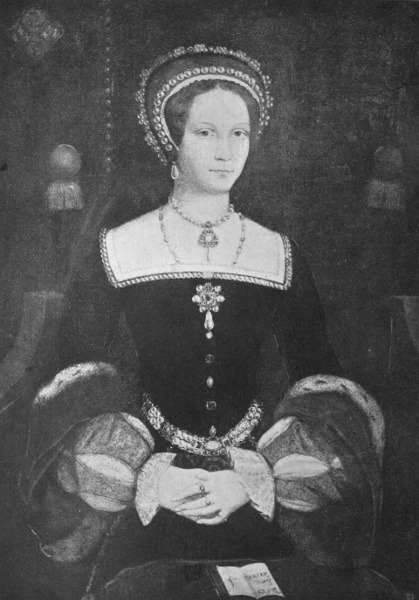
So this entire post was a prank.
I hope you’ve enjoyed it and that I fooled many of you.
27 notes
·
View notes
Photo
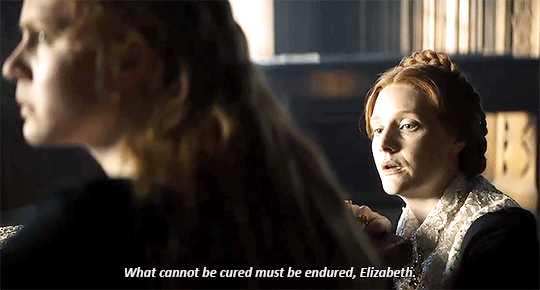

#Becoming Elizabeth#becomingelizabethedit#Princess Mary#Princess Elizabeth#Queen mary I#Queen Elizabeth I#BES1E6
82 notes
·
View notes
Text
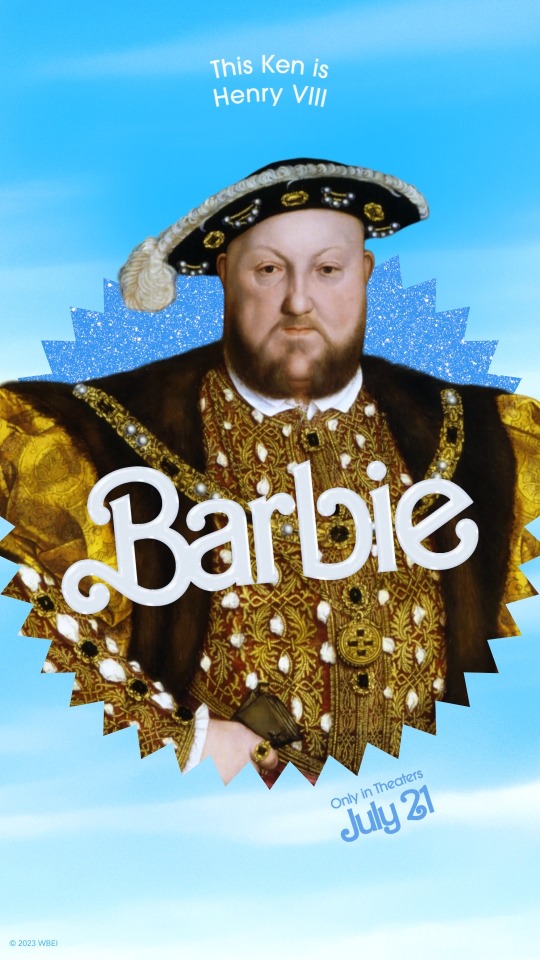
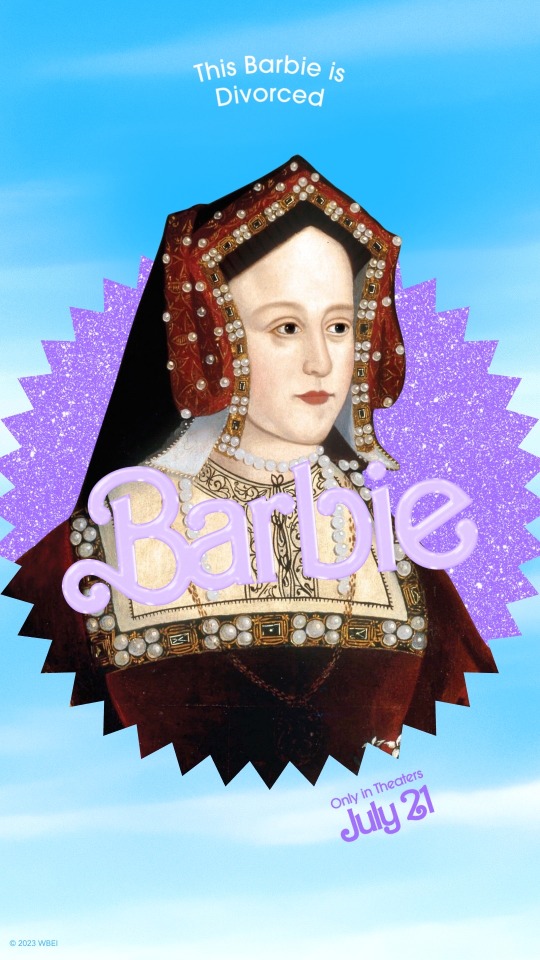





Meet the Barbies
#idk what this is#i’m sorry#catherine of aragon#anne boleyn#jane seymour#anne of cleves#katheryn howard#katherine parr#henry viii#Barbie#barbie the movie#mary i#elizabeth i#elizabeth i of england#queen elizabeth i#queen elizabeth i of england#queen mary i#queen mary i of england#mary i tudor
314 notes
·
View notes
Text

Elizabeth I and Mary I
#queen elizabeth i of england#elizabeth tudor#mary tudor#queen mary#queen mary i#queen aesthetic#queen things#valentines#valentines aesthetic#valentines moodboard#royal siblings#queen anne boleyn#Anne Boleyn#queen catherine#catherine of aragon#the tudors#tudor rose#royal moodboard#royal aesthetic#tudorsedit#tudor dynasty#sarah bolger#laoise murray#tudor era#tudor tag#perioddramasonly#perioddramaedit#period drama#perioddramacentral#tudoredit
26 notes
·
View notes
Text
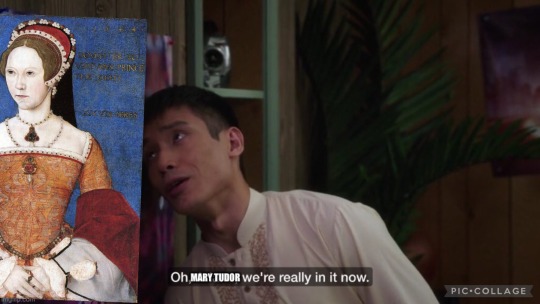
Dysmenorrhea and possible endometriosis got me like
(For context, Mary’s menstrual cycles were said to be exceptionally painful and many suspect she may have had endometriosis and/or PCOS)
#tw menstruation#tw periods#endometriosis#pcos#mary tudor#queen mary i#bloody mary#memes#period memes#dysmenorrhea#tudor memes#Endometriosis memes
75 notes
·
View notes
Link
Finally got castings new for that “My Lady Jane” comedy series they’re making at Amazon and I’m so excited to see that they’ve added some of my favorite British actors like Dominic Cooper as Edward Seymour, Rob Brydon as John Dudley, and Anna Chancellor as Jane Grey’s mom. They’ve also added a few other actors in unnamed roles but some are young enough that I think they are adding Queen Elizabeth I and Robert Dudley as they weren’t originally in the book but 2 of the younger cast look like them. The book again is a supernatural comedy AU about Jane Grey if she lived and her marriage to Guildford Dudley.
#my lady jane#lady jane grey#guildford dudley#john dudley#robert dudley#queen elizabeth i#queen mary i#king edward vi#dominic cooper#rob brydon#anna chancellor
43 notes
·
View notes
Text


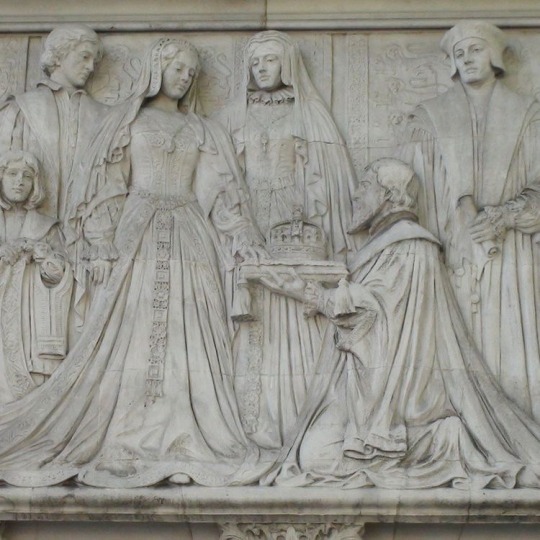
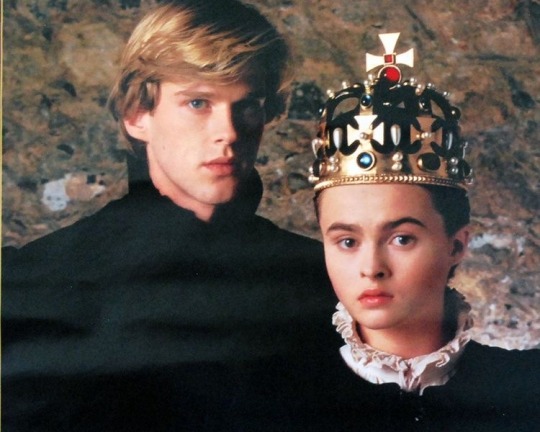
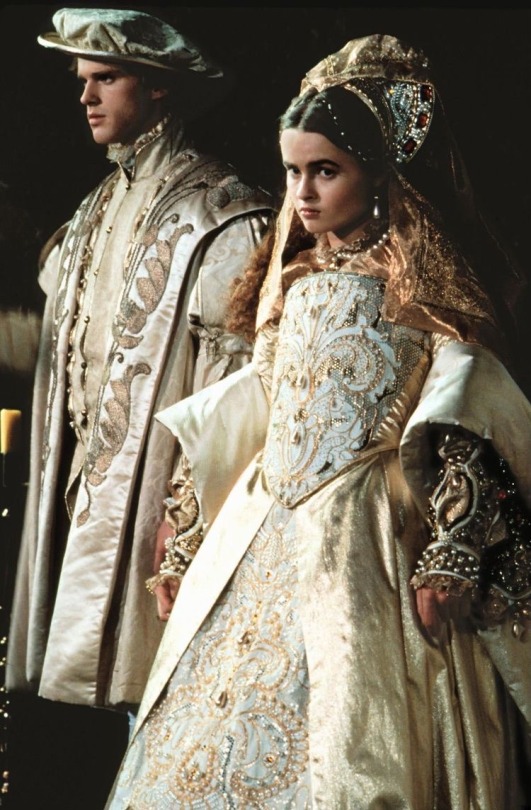
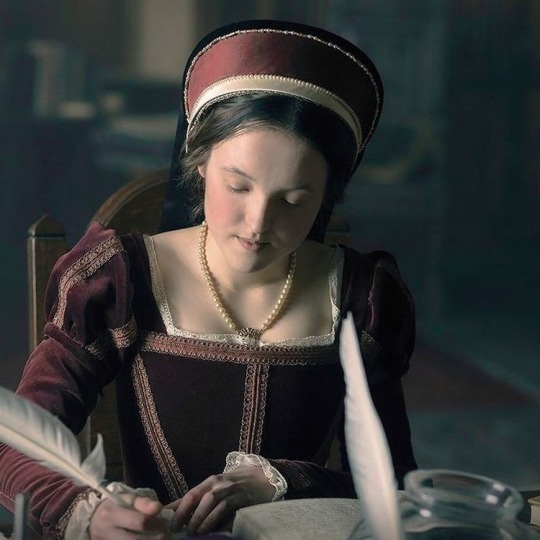
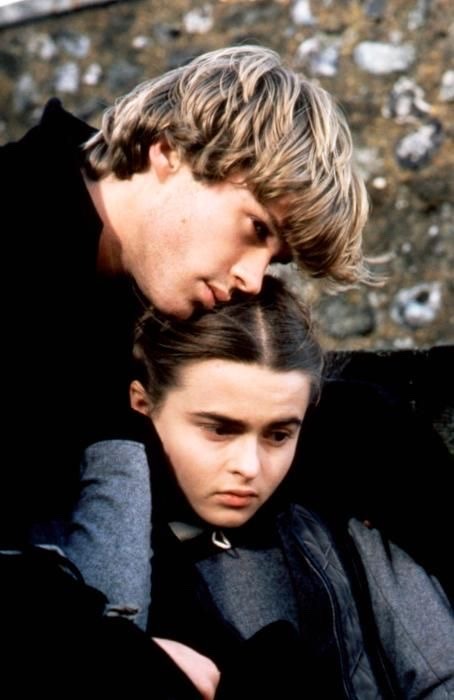
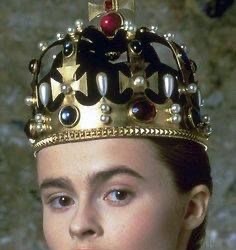


Queen/Lady Jane Grey (The Queen for Nine Days)
Lady Jane Grey, later known as Lady Jane Dudley after her marriage and then she was known as the "Nine Days Queen". She was an english noblewoman who claimed the throne of England and Ireland from July 10 - July 19 1553.
She was the great granddaughter of Henry VII through his younger daughter Mary, making her first cousin once removed of Edward VI (Henry's son and successor)
She has an excellent humanist education, and a reputation as one of the most learned women of her day. She was married in May 1553 to Lord Guildford Dudley, a younger son of Edward's chief minister.
June 1553, Edward VI wrote his will nominating Jane and her male heris as successors to the crown upon his death, this was in part do to religion that differed between himself and his half sister Mary Tudor who was supposed to succeed him according to Henry VIII's will. This change would not only remove his half sister Mary but also his half sister Elizabeth Tudor from the line of sucession on account of their illegitimacy.
After Edwards death, Jane was proclaimed queen on July 10th 1553 and awaited her coronation in the Tower of London. Support for Mary quickly grew while most of Jane's supporters abandoned her - including the English government. The privy council proclaimed Mary Tudor as Queen on July 19th 1553, deposing Jane.
Her prime supporter and Edwards old chied minister (Jane's father in law) was accused of treason and executed less than a month later.
Jans on the otherhand was held prisoner in the Tower of London and was convicted of high treason in November 1553 - a death sentence in of its own.
Mary initially spared her life. However Jane soon became viewed as a threat to the crown when her father, Henry Grey became involved with the Wyatt's rebellion against Queen Mary's intention to marry Philip of Spain.
Jane and her husband were executed on February 12th 1554, at the time of her death Jane was only either 16 or 17 years old.
Jane was the eldest daughter of Henry Grey, 1st Duke of Suffolk with his wife Frances Brandon. No one knows exactly when she was born though there are many theories; October of '37, May of '37, May of '36, or February of '37.
Jane's mother was the eldest daughter of Henry the eighths younger sister, Mary. Jane also had two younger sisters; Lady Katherine and Lady Mary Grey.
She spoke Latin and Greek from an early age, she also studied Hebrew and Italian as well. She was a commited protestant.
She much preferred academic studies as apposed to activities such as hunting parties. She may even have believed her strict upbringing, something very common at the time, to have been too harsh.
Around February 1547, Jane was sent to live in je household of Edward VI’s uncle, Thomas Seymour, who was soon to be married to Catherine Parr. Henry VIII’s widow.
She was an attendant to Catherine up until her death during childbirth in September of 1548. She was close to Catherine and was even involved in her funeral
When Thomas Seymour was convicted of treason, Jane proceeded to return home and continue her studies.
Throughout her life she had a few engagement talks but nothing was made of them until May 25th 1553. That same day the couple was married at Durham House in a triple wedding. The wedding of on of each of the couples sisters was also happening.
The third succession act of 1544 restored Henry VIIIs daughters to the line of succession although they were still regarded illegitimate. This act also gave Henry the ability to alter the line of succession through his will. It reinforced the succession of his three children and declared should none of them leave descendants the throne was to be passed to heirs of his younger sister, this included Jane.
For unknown reasons when making the succession, Henry excluded Jane's mother as well as the claims of his own older sister.
During Henry's reign both of his daughters had been named illegitament when his marriages to their mothers were declared void.
15 year old Edward VI lay dying in the summer of 1553, with Mary still as his pressumed heir. Edward however in a draft will ("my devise for the succession") which was composed in early 1553, had first restricted the succession to (non-extistant) male descendants of Frances Brandon and her daughters, before he named his protestant cousin. "Lady Jane and her male heirs" as his successors.
Probably in June 1553 the intent was to ensure his protestant legacy - removing Mary who was a devoted Roman Catholic
Edward personally supervised the copying of his will which was issued on June 21st and signed by 102 notables. He also announced to have his "declaration" passed in parliament in September.
The King died on July 6th 1553, however his death was not announced for four days. On the 9th, Jane was informed she was now queen - claiming to accept the crown only with reluctance.
The 10th, she was officially proclaimed Queen of England, France, and Ireland. After she had taken up a secured residence within the Tower of London (usually where monarchs lived from time of accession until coronation). Jane refused to name her husband as king, since it would require an Act of Parliment.
A goal of many at this time was to isollate and attempt to capture Mary Tudor to stop her from gaining any further support.
When Mary was sure of the demise of her half brother, she left her residence at Hunsdon and set eyes for East Anglia where she began to rally her support.
Jane is often labelled the Nine Days Queen, although her technically reign goes from Edwards true death on the 6th - making it a few days longer. July 19th Jane is imprisoned in the Tower's gentlemen gaoler's apartments while her husband was in the Beauchamp Tower.
September parliament declared Mary the rightful successor and denounced and revoked Jane's proclaimation as that of a usuper.
Jane was charged with high treason as were her husband, two of his brothers, the former archbishop of Canterbury, and Thomas Crammer.
Trial by special commission took place in November 13th 1553, as to be expected all defendants were found guilty and sentenced to death. Jane's guilt of having treacherously assumed the title and power of a monarch, with evidence of a number of documents she signed as "Jane the Quene".
Her sentence was to "be burned alive on Tower Hill or beheaded as the Queen pleases."
Burning was traditional english punishment for treason when it was committed by a woman.
The imperial ambassador reported to Charles V, Holy Roman Emperor, that her life was ro be spared by Queen Mary.
Wyatt's rebellion in January 1554 against Queen Mary's marriage plans with Philip of Spain however sealed Jane's fate in a different way. Her father, Henry Grey and his two brothers joined the rebellion, and so the government and Queen Mary decided to go through with there verdict for Jane ans her husband.
Their executions were first seceduled for February 9th 1554 but was postponed for three days to give Jane a chance to convert to the Catholic faith.
On the morning of February 12 1554 they took Guildford from his rooms within the Tower of London to the public execution place on Tower Hill where he was then beheaded. his remains were brought back to the tower past Jane's rooms, she was then taken out to Tower Green inside the Tower to be beheaded.
She made a speech as she ascended the scaffold, the resighted Psalm 51 (have mercy upon me, o god). She handed her gloves and handkerchief to her maids. The executioner asked her for forgiveness which she granted. she then blindforlded herself. She failed to find the block by hand and cried out, once helped with her head upon the block Jane spoke her last words.
"Lord into thy hands i commend my spirit." the axe then fell beheading the young girl in one clean stroke.
Jane and her husband were buried in the Chapel of St Peter ad Vincula on the north side of the tower green. No memorial stone was erected at their grave.
Jane's father was executed 11 days after Jane on the 23rd of February 1554.
Her mother, Duchess of Suffolk married her Master of Horse and Chamberlain - Adrian Stokes in March of 1555. She was fully pardoned by Queen Mary and allowed to live at court with her two surviving daughters. She died in 1559.
During Mary's reign Jane became viewed as a protestant martyr for centuries to come.
#college student#college life#chronicles of a sick person#adult ish#social distancing#long live the queue#it was always queue#all queued up#college#lady jane grey#jane grey#queen Jane grey#queen of england#england#elizabeth tudor#mary tudor#queen mary#bloody mary#queen mary i#queen elizabeth i of england#edward tudor#king Edward#king of england#history#history facts#english history#historical
12 notes
·
View notes